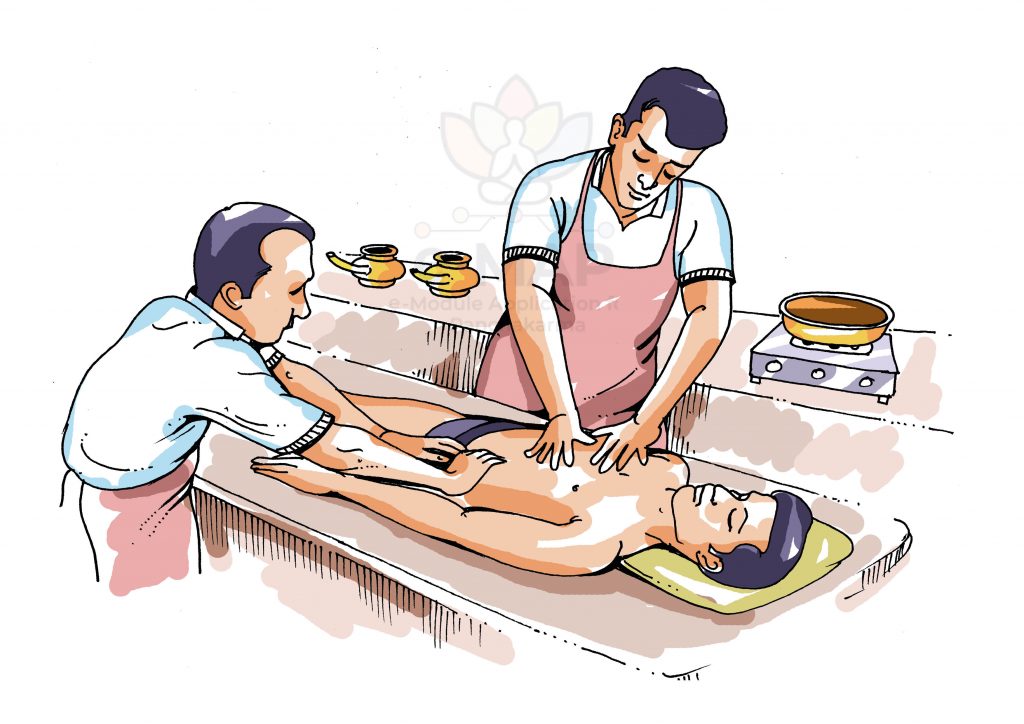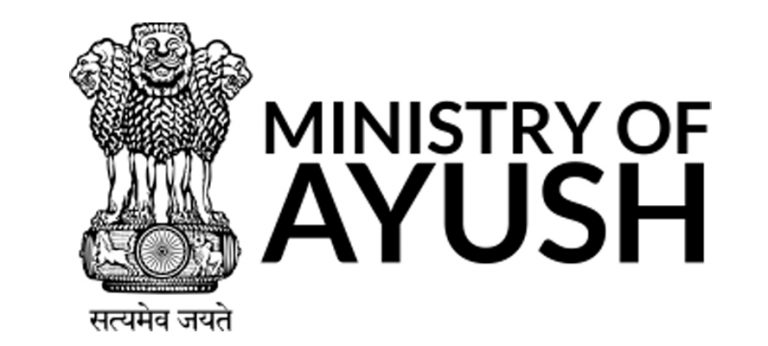
Intense Module 1
Introduction

EXPLANATORY NOTES
Differential diagnosis based on nidana
ĀMAVĀTA | SANDHIGATAVĀTA | VĀTARAKTA | |
Āhāra |
Viruddhāhāra, Atimātrāhāra, Snigdhāhāra, |
Tikta, Kaṣāya, Uṣṇa, Rūkṣa, Alpānna |
Lavaṇa, Kaṭu, Amla, Kṣāra, Snigdha , Uṣṇa, Viruddha, Klinna & Anūpa Māṃsa, Kulattha, Māṣa, Niṣpāva, Dadhi, Sauvīra
|
Vihāra |
Viruddha Vihāra, Niścalatā, Doing Vyāyāma immediately after taking Snigdhāhāra |
Athivyāyāma, Atimaithuna, Atiplavana, Atiadva, Aticeṣṭa,Yāna in camel, horse & falling from this |
Sukumāra, Acaṅkramaṇaśīla, Haya Uṣṭra Yāna, Ambukrīḍa, Plavana, Laṅghana, Sthūla, Avyāyāma
|
Mānasika |
If person taking Āhāra with Cintā, Bhaya, Śokopatapta Manas |
Excessive fear, grief |
Krodha |
Nidrā |
Not mentioned |
Divāsvapna, Atiprajāgara |
Divāsvapna, Prajāgara
|
Injuries |
Not mentioned |
Abhighāta, Marmāghāta |
Abhighāta |
Cikitsābhraṃśa |
Not mentioned |
Atiyoga of Vamanādi Kriya |
Not mentioned |
Differential diagnosis based on saṃprāpti ghaṭaka
ĀMAVĀTA | SANDHIGATAVĀTA | VĀTARAKTA | |
Doṣa |
Tridoṣa [spl – Āma & Vāta] |
1) Dhātukṣayajanya – Vāta 2) Āvaraṇajanya – Vāta & Āvaraṇa Doṣa |
Vāta & Rakta
|
Dūṣya | Rasa( Agnimāndya, Praseka, Aṅgamarda, Jvara) Kapha( Aṅgamarda, Ālasya, Utsāhahāni, Agnimāndya) Vāta (Bhrama, Mūrcchā, vit Vibandha, Nidrānāśa) Māṃsa (Sandhi Śūla) Majjā( anga Gaurava) |
Majjā – Māṃsa( Sandhi Śūla) Meda (Sandhi Śopha) Asthi (-) (Asthi Śūla) Majjā (-) (Asthi Śūnyatā) Śūla |
Uttana – Rakta, Māṃsa Gambhīra – Sapta Dhātus Vāta (+) (Kārṣṇya, Sphuraṇa) Kapha (-) (Sandhi Śaithilya) Rakta (Kuṣṭha Lakṣaṇa, Vaivarṇya, Maṇḍalotpatti, Agnināśa)
|
Srotas
|
Annavaha (Apāka, Aruci, Chardi) Rasavaha (Aruci, Agnimāndya) Udakavaha (Tṛṣṇā) Raktavaha (Jvara, Dāha) Majjāvaha (Bhrama, Mūrcchā) Mūtravaha (Bahumūtrata) Purīṣavaha (Vit Vibandha)
|
Rasavaha (vitiated by Nidāna) Asthivaha (Asthibheda, Asthiśūla)
|
Svedavaha (Asveda / Atisveda, Sparśa Ajñatā, Kaṇḍu) Majjāvaha (Pārśvaruk) Raktavaha (Piḍakotgama, Dāha, Maṇḍala)
|
Agni Duṣṭi | Mandāgni | Mandāgni |
Mandāgni
|
Sroto Duṣṭi | Saṅga (Srotāmsi Limpati) | Saṅga |
Saṅga, Vimārga Gamana
|
Udbhava Sthāna | Āmāśaya | Pakvāśaya |
Pakvāśaya, Sirā
|
Adhiṣṭhāna | All Sandhis (smaller—bigger) | Major Sandhi |
Parva
|
Rogamārga | Ābhyantara, Madhyama | Madhyama |
Bāhya, Madhyama
|
Svabhāva | Cirakāri | Cirakāri |
Uttāna – Āśukāri Gambhīra – Cirakāri
|
Differential diagnosis based on sthĀna
|
ĀMAVĀTA |
SANDHIGATAVĀTA |
VĀTARAKTA
|
Sthāna |
• Full Gātra ( causing Stambhana) – Kapha & Vāta reaching Trika Sandhi affects the Ambu Karma of Avalambaka Kapha gradually affecting the Jalīya content of body causing Gātrastambhana • Hasta – Pāda – Śiro – Gulpha – Trika – Jānu – Uru Sandhis
|
Sandhi
|
SU – 1st Hasta & Pāda after that Deha Cha – 1st Hasta Pāda – then Kara Pāda Aṅgulī, Sarvasandhi AH – 1st in Pāda / sometimes in Hasta, then it spreads to the entire body like Ākhu Viṣa (It first affect the legs especially of those who keep them hanging when riding on animals) Uttana – Tvak Māṃsa Gambhīra – Sarva Dhātu
|
Differential diagnosis based on rūpa
ĀMAVĀTA |
SANDHIGATAVĀTA |
VĀTARAKTA | |
Digestive | Agnidaurbalya, Apāka, Aruci, Tṛṣṇā, Praseka, Kukṣi Kaṭhinatā, Ānāha
|
| |
Skeletal | Saruja Śopha in Hasta – Pāda – Śiro – Gulpha – Trika – Jānu – Uru Sandhis Saṅkoca, Khañja
| Hanti Sandhi, Āṭopa, restricted and painful flexion, extension
| Gambhīra Vātarakta – Stabdha Vāta – Vegavān / Balavān – Sandhi Asthi Majjāsu Caraṇa – cutting pain, Vakrī Kurvatī – If Sarva Śarīra Caraṇa – Khañja, Paṅgu
|
Body | Aṅgamarda, Gaurava
| ||
Associated symptoms | Jvara, Chardi, Hṛtgraha, Bhrama, Mūrcchā
| Sandhi Vakratā [deformity] & Sandhi Pāka in Gambhīra Vātarakta | |
Pain | Painful swelling [Saruja Śopha] Pateint feels like Vyāviddha iva vrischikai
| Sandhi Śūla [Su] Pain while doing Prasāraṇa & Ākuñjana [AH]
| Gambhīra – Pain is Atyanta Dussaha for patient More painful than Uttāna Vātaja – Śūla /colic pain Sphuraṇa / Throbbing, Nistoda / pricking Raktaja – Bhṛśaṃ Atiruk, Cimicimāyana
|
Site of pain | Hastapādādi Sandhis
| Sandhi | Uttāna – Tvak, Māṃsa Gambhīra – At site of inflammation, & Sandhi – Asthi – Majjā
|
Swelling | Aṅga Śūnatā
| Vāta Pūrṇa Dhṛti Sparśa Śopha in Sandhi | Uttāna – Swelling & coppery discolouration Gambhīra – Śvayathu – Stabdha, Kaṭhina, Antarārti, Pākavān Vātaja – contraction of joints
|
Excretory | Bahumūtrata , Vit Vibandha
|
| |
Sleep | Nidrānāśa
| ||
General | Ālasya, Utsāha Hāni
| ||
Sensory changes in skin | Dāha
| Uttāna – Kandu, Dāha, Toda, Sphuraṇa, Kuñjana Gambhīra – Dāha, Toda, Sphuraṇa
| |
Colour changes in skin
|
Uttāna – Śyāva Rakta/ Tāmra Gambhīra – Śyāva Tāmra
|
Differential diagnosis based on modern aspect
ĀMAVĀTA(RA) |
SANDHIGATAVĀTA(OA)
| VĀTARAKTA(GA) | |
CONDITION |
Autoimmune Inflammatory disease |
Degenerative change
|
Inflammatory condition due to high amount of uric acid crystals in the joints |
INVESTIGATION | ESR, CRP,TC, rheumatoid factor assay, antinuclear antibody assay, radiography | X- ray, MRI, CT, bone scanning
| Serum uric acid, synovial fluid analysis, kidney stone test |
AGE | Begin at any time in life ~25-45 years More in females | >= 50 years Obese people
| More in males |
MORNING STIFFNESS | Present Lasts longer than 1 hour | Stiffness after periods of activity
| Present During early hours of day |
NATURE | Chronic Symmetrical symptoms | Chronic Pain with movement, improves with rest Reduced ROM Crepitus, spur formation, warmth
| Acute Severe pain, redness, tenderness in joints Strike the big toe then migrate to other joints |
FEVER | present | Absent usually
| Present |
AREAS OF RESEARCH IN PAÑCAKARMA
Āyurveda and Pañcakarma is gaining worldwide popularity now a days. Even though Āyurveda is a time-tested medicine still there is need of systematized scientific research. It can be conducted at Government and Private Āyurveda Colleges for PG, PhD levels, Government Research Institutes like CCRAS and its peripheral institutes like NARIP and other NGO’s.
The CCRAS has been executing its research programmes with a network of 30 peripheral Institutes/centres/units with the headquarters office at Delhi responsible for control, monitoring and supervision.
The broad areas of Research comprise:
- Clinical Research
- Fundamental Research
- Pharmacology Research (Pre clinical Safety/Toxicity and Biological Activity Studies)
- Medicinal Plant Research (Medico-Ethno Botanical survey, Cultivation, Pharmacognosy) Drug standardization Research
- Literary Research & Documentation [i]
There are lots of area in Pañcakarma where research can be conducted. The National Āyurveda Research Institute for Pañcakarma, Cheruthuruthy, Kerala was started on 21st June, 1971 and has over the years grown tremendously in terms of infrastructural facilitates and the number of patients who are being treated, both in OPD and IPD.
AREAS OF RESEARCH IN SNEHANA
These are some of the areas where research can be conducted.
- Research on Śodhanārtha – Śamanārtha and Bṛṃhaṇa Sneha
- Research on Pravicāraṇa Sneha
- Research on Śodhanāṅga Sneha on Lipid Profile
- Research on Caturvidha Sneha and its effect on body
- Vardhamāna Sneha Mātrā
- Standardization of Sneha Mātrā in different Snehapāna
- Effect of Medicated and Non-Medicated Ghee
- Sadyo Snehana
- Agni and Koṣṭha Parīkṣā before Snehapāna
- Mode of action of Snehapāna
- Research on Avapīḍaka Snehapāna and its effect in diseases
- Research on Uttarabhaktika Snehapāna and its effect in diseases
- Sneha Pāka and its role in various treatments.
- Effect of various Anupānas in Snehapāna
- Assessment of Sneha Jīryamāna and Jīrṇa Lakṣaṇas
- Assessment of Samyak – Ayoga and Atiyoga Lakṣaṇas
- Procedural Standardization of different Mūrdhataila
- Procedural Standardization of different Bāhya Basti
- Śirodhārā with various Dravyas
- Bāhya Basti and its effect in various diseases
- Modifications in materials used in various Bāhya Basti
- Procedural Standardization of various Bāhya Basti
AREAS OF RESEARCH IN SVEDANA
These are some of the areas where research can be conducted.
- Carakokta Trayodaśa Sveda and its modifications
- Caturvidha Sveda and its modifications
- Niragni Svedas
- Mode of action of Svedana
- Samyak – Ayoga and Atiyoga Lakṣaṇas of Svedana
- Effect of various Piṇḍa Svedas on the body in different diseases
- Effect of Kāyaseka on the body in different diseases
- Effect of Kāyaseka with different Dravya on the body in different diseases
- Modern techniques of Svedana / Steam Bath
- Effect of Dhānyāmla Dhārā in different diseases
- Svedana for Bāla
- Different types of Thermotherapies and Svedana
- Procedural Standardization of different Bāhya Basti
- Procedural Standardization of different Piṇḍa Sveda
- Procedural Standardization of different Dhārā
- Effect of Svedana on different body parameters.
AREAS OF RESEARCH IN VAMANA
These are some of the areas where research can be conducted.
- Standardization on the dose of Vāmaka Yogas in Kalpa Sthāna
- Vamana with different Vāmaka Yogas told in Kalpa Sthāna
- Sadyo Vamana Procedure
- Sneha Pūrvaka Vamana and Sadyo Vamana
- Various Vamanopaga Dravyas
- Assessment of Vegikī Śuddhi
- Assessment of Mānikī Śuddhi
- Assessment of Āntikī Śuddhi
- Assessment of Laiṅgikī Śuddhi
- Pittāntha Vamana and its analysis
- Samyak – Ayoga and Atiyoga Lakṣaṇas of Vamana
- Effect of Vamana in various diseases
- Comparative study of Vamana and Virecana in various diseases.
- Mode of action of Vamana
- Effect of Vamana on various body and laboratory parameters.
- Study of different type of unique Vāmaka Yogas in Kalpa Sthāna
- Standardization of Vamana Karma
- Saṃsarjana Krama according to Śuddhi
AREAS OF RESEARCH IN VIRECANA
These are some of the areas where research can be conducted.
- Standardization on the dose of Virecana Yogas in Kalpa Sthāna
- Virecana with different Virecana Yogas told in Kalpa Sthāna
- Sneha Pūrvaka Virecana and Sadyo Virecana
- Various Virecana Dravyas
- Assessment of Vegikī Śuddhi
- Assessment of Mānikī Śuddhi
- Assessment of Āntikī Śuddhi
- Assessment of Laiṅgikī Śuddhi
- Kaphānta Virecana and its analysis
- Samyak – Ayoga and Atiyoga Lakṣaṇas of Virecana
- Effect of Virecana in various diseases
- Comparative study of Vamana and Virecana in various diseases.
- Mode of action of Virecana
- Effect of Virecana on various biochemical and haematological parameters.
- Study of different type of unique Virecana Yogas in Kalpa Sthāna
- Standardization of Virecana Karma
- Standardization of Virecaka Yogas w.s.r to Koṣṭha
- Standardization of Anulomana – Sraṃsana – Bhedana – Virecana
- Saṃsarjana Krama w.s.r to Śuddhi
- Ṛtu Trivṛt Yogas
- Śodhana Vyāpat
AREAS OF RESEARCH IN BASTI
These are some of the areas where research can be conducted.
- Standardization of Basti Procedures
- Standardization of dose of Nirūha and Anuvāsana Basti
- Pharmacokinetics of Nirūha Basti
- Pharmacokinetics of Anuvāsana Basti
- Effect of Basti on Biochemical and Haematological Parameters
- Mode of action of Basti
- Samyak – Ayoga and Atiyoga Lakṣaṇas of Nirūha Basti
- Samyak – Ayoga and Atiyoga Lakṣaṇas of Anuvāsana Basti
- Effect of different kinds of Basti in various diseases
- Standardization of the dose of Mātrā Basti
- Standardization of the dose of Anuvāsana Basti
- Standardization of the dose of Nirūha Basti
- Anuvāsana Basti in Ārohaṇa Krama Mātrā
- Mātrā Basti and Snehapāna
- Karma – Kāla – Yoga Basti Krama
- Different kinds of unique Basti Yogas in various Saṃhitās
- Traditional and modified Basti Netra and Basti Puṭaka
- Basti Netra and Basti Puṭaka Doṣas
- Standardization of Basti in new modifications
- Assessment of Basti Pratyāgamana Kāla on various parameters
- Parihāra Kāla in Basti
- Standardization of Basti Netra measurements according to age.
- Standardization of Basti dose according to age
- Uttara Basti and Catheterization
- Standardization of Uttara Basti in Male
- Standardization of Uttara Basti in Feale
- Mode of action of Basti
- Basti Vyāpat
- Caturbhadra Kalpa Basti
- Cūrṇa Basti
- Comparative study of various Basti Yogas in different diseases
- Mode of action of Basti
- Yāpana Basti
- Modifications of Basti Netra and Basti Puṭaka in present day
- Procedural Standardization of Basti
AREAS OF RESEARCH IN NASYA
These are some of the areas where research can be conducted.
- Standardization of different Nasya
- Dose of Nasya in present day measurements
- Nasya with Āvartita Taila and regular Taila
- Sneha Pāka and Nasya
- Different Sneha Dravyas for Nasya
- Samyak – Ayoga and Atiyoga Lakṣaṇas of different Nasya
- Mode of action of different Nasya
- Modifications in different Nasya
- Nasya Vyāpat
- Paścāt Karma in Nasya
- Different types of Nasya and Medicines used for the same.
AREAS OF RESEARCH IN RAKTAMOKSHA
These are some of the areas where research can be conducted.
- Different types of Jalaukā
- Jalaukā Saṅgrahaṇa and Saṃrakṣaṇa
- Procedural Standardization of Jalaukāvacaraṇa
- Procedural Standardization of Pracchāna
- Procedural Standardization of different areas of Sirāvyadha
- Procedural Standardization of Śrṛṅga Avacaraṇa
- Procedural Standardization of Alābu Avacaraṇa
- Cupping Therapy
- Assessment of various haematological and bio chemical parameters during Raktamokṣaṇa
- Assessment of Water and Electrolyte Imbalances, Shock etc.
- Assessment of different Raktamokṣaṇa in various diseases
SCOPE OF RESEARCH IN STANDARDIZATION OF PAÑCAKARMA PROCEDURES
There is a good research article by Dr. Devi. R on this topic[ii]. The findings of the same are explained below.
STANDARDIZATION OF CONCEPT BEHIND DESIGNING OF A PAÑCAKARMA PROTOCOL
The accumulated cellular toxins (Āma) have the characteristic property of Picchilatva (stickiness). So, the first step needed to bring it into the alimentary canal is nothing other than its liquefaction and increasing its volume (Abhiṣyandana) which is done by a procedure called “Snehapāna” in which medicated/non-medicated ghee/oil/ fat is given orally in a systematically increasing dose under controlled conditions for maximum upto 7-9 days or upto the development of Samyak Snigdha Lakṣaṇa (symptomatology of proper oleation). After making liquefaction of cellular waste through Snehapāna, next step is Svedana (sudation) by which these liquifacted wastes will be directed towards alimentary canal. When these cellular waste reaches alimentary canal, it can be expelled out as per the proximity by Vamana (vomiting) therapy or Virecana (purgation) therapy. If the patient’s age or health status is not suitable for Snehapāna or Svedana therapy, alternative methods like Abhyaṅga (Bāhya Snehana), Piṇḍa Svedas (Poṭalī sudation) etc can be opted.
After proper administration of Pūrvakarma procedures, according to the proximity and location of Doṣa, Vamana therapy (emesis) or Virecana therapy (purgation) can be planned. Usually, enema therapy (Basti ) is doing after the initial level of purification or can be done prior under specific medical indications and some emergency conditions. In the case of Doṣa localized on head and neck, Nasya therapy (nasal administration of medicine) is beneficial.
This concept behind the designing of a Pañcakarma protocol should be standardized.
STANDARDIZATION OF PŪRAKARMA PROCEDURES
(I) Standardization of medicine (Oil/Ghee/ Poṭalī ):
The criteria behind the selection of which type of Snehana and Svedana method needed to be administered in a given patient can be designed by following the steps of Daśavidha Parīkṣā.
(ii) Standardization of methodology of preparation:
As far as Poṭalī / Piṇḍa Sveda are concerned, its ingredients, quantity of each ingredient and method of preparation should be standardized. As per patient’s health status, quantity of each ingredient can be scientifically altered.
For example, if the patient has more Kapha Doṣa symptoms like swelling, quantity of coconut scrapings inside Patra Piṇḍa Sveda can be reduced and quantity of lemon which is anti-inflammatory can be increased. The order of steps of preparation of Poṭalī Sveda should be also standardized.
(iii) Standardization of administration of procedure:
The methodology in which a procedure is administered should be standardized and validated or in other words, validation of Standard Operative Procedure (SOP) should be done for Snehapāna, Abhyaṅga, Piṇḍa Sveda or any Pūrvakarma procedure.
(iv)Standardization of Samyak Lakṣaṇa (symptomatologies) or development and validation of tool to assess the procedure:
Development of proforma can be done under the following steps:
- Compilation of symptomatologies
Should be collected meticulously from all the available classical literature.
- Item analysis:
Which include reduction of symptoms which are similar words and similar meanings. Each and every collected symptom should be analysed by its root word, meaning, implication etc by thorough analysis and those symptoms having same meaning should be reduced
and only one should be selected.
- Literature review:
Current available research works and publications should be thoroughly analysed to look for any other additional symptoms noticed during the performance of the procedure.
- Clinical observation:
With this developed pro forma, the researcher has to go to the Pañcakarma theatre for observation of these symptoms in patients.
- Finalization:
As per the degree of clinical observation, finalization of pro forma should be made.
This developed pro forma should be subjected to different stages of validation like face validity, content validity by subject experts, construct validity and criterion validity which involve the comparison of developed pro forma with available gold standard.
STANDARDIZATION OF PRADHāna KARMA PROCEDURES
Vamana Karma
Vamana therapy is nothing other than medically induced vomiting by consumption of prescribed drug which involve the stimulation of Chemoreceptor Trigger Zone (CTZ), solitary tract nucleus and finally the vomiting centre medulla oblongata which stimulate phrenic nerve, vagus nerve and intercostal nerves to induce vomiting. The medicine used, collection and processing of Vamana medicine, its dosage, Anupāna should be standardized along with the standardized implementation of Vamana protocol and patient regimen.
Virecana Karma
As far as Virecana therapy is concerned, prior diet, level of Virecana needed in the particular disease, procedure of Virecana as a whole, tool to assess Samyak Virecana Lakṣaṇa in a particular disease, time of administration of Virecana medicine etc need standardization. Level
of Virecana needed, whether it is Anulomana or Sraṃsana or a Bhedana Karma, depends on several criteria including strength of Doṣa vitiation, Rogi Bala etc. For example, in Pakṣāghāta (hemiplegia), only Anulomana is indicated whereas in Kuṣṭha, due to Bahudoṣāvasthā (huge vitiation of Doṣa), classical Virecana is needed.
Basti Karma
Include both Nirūha Basti (enema with medicated Kvātha) and Anuvāsana (enema with medicated oil). It can be done as scientifically designed packages like Kāla Basti , Yoga Basti etc or can be done alone in specific conditions like Āmavāta (vaiswanara Cūrṇa Basti ). The criteria for going into packages or doing it alone need standardization. Standardization of Basti procedure also involve standardization of Pīḍana Kāla (pressing time of Basti bag), standardization of procedure of mixing of Basti Dravya, positioning of patient, diet during Basti, time of administration of Basti etc.
Nasya Karma
Modern research works point out to the existence of naso-brain pathway which is the fastest promising drug delivery route. To enable fastest drug absorption directly to the brain, drug has been believed to be absorbed through arachnoid matter sleeve which extends along olfactory nerve. For that standardization of nasya procedure has to be performed including points like positioning of head of patient while during Nasya Karma, standardization of Hasta Svedana technique which may provide facial efferent stimulation, standardization of dose and Bindu Pramāṇa w.s.r.to each Nasya Dravya, standardization of time, tool development for Samyak Nasya Lakṣaṇa etc.
STANDARDIZATION OF DIET DURING PAÑCAKARMA PROCEDURES
Food items used during Pañcakarma treatment course cannot be standardized fully owing to the cultural sensitivity of the patients of different regions in which Pañcakarma is practised. Even though food items cannot be standardized, the principle behind diet used during different stages should be standardized. Scientifically designed diet protocol just after Pañcakarma therapy aiming at the restoration of body elements which were medically-disturbed during procedure is known as Saṃsarjana Karma. The principle of Saṃsarjana Karma, which begin with carbohydrates then proteins ending with fats should be standardized and implemented. Also, the dietary regimen advised during Snehapāna , Svedana, Basti etc should be standardized on scientific lines. Efficacy of Vamana and Virecana therapy largely depends on the diet consumed on previous day or prior diet which is known as utklesana diet designed for liquefaction of Kapha and Pitta Doṣa respectively also need standardization.
STANDARDIZATION OF PAÑCAKARMA THEATRE
Pañcakarma theatre should be set and standardized as per NABH criteria which includes proper light supply and ventilation, hygienic, with separate hand – washing area, storage area, recovery room, hot water supply etc with accurate instruments. The room should be also
free from vectors.
STANDARDIZATION OF INVESTIGATIONS DURING PAÑCAKARMA
Investigations done during Pañcakarma procedure is to ensure the safety of the procedure and to make scientific assessment on parameters. Vitals should be checked before and after every procedure. The specific investigations vary as per the procedure, for example, Raktamokṣa or bloodletting therapy should not be conducted in case of low Hb level, abnormal bleeding and clotting times. Portal hypertension and oesophageal varix should be screened before Vamana therapy. In case of bleeding haemorrhoids, Basti cannot be administered. Hypotensive patients cannot be done a purgation therapy. The investigation list needed to be done prior to each Pañcakarma and after therapy should be made scientifically and validated.
[i] http://ccras.nic.in/content/research-Āyurveda
[ii] https://www.worldwidejournals.com/indian-journal-of-applied-research-(IJAR)/article/scope-of-research-in-standardization-of-Pañcakarma-procedures-a-critical-review/MTQyNjM=/?is=1&b1=49&k=13



